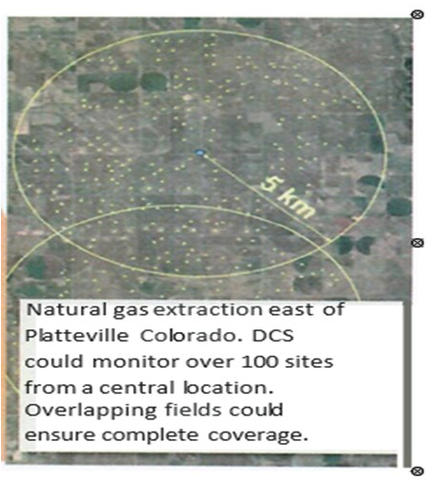Problem
Patent Description
The current practice for detecting methane leaks is still in its infancy. There are several environmental regulations that have driven the development of Forward-looking Infrared (FLIR) cameras, thermographic cameras that senses infrared radiation, for detection of Volatile Organic Chemicals (VOCs), a category that includes methane. These FLIR cameras are the principle means for detecting leaks but suffer from several problems. FLIR cameras are expensive, require a human operator, and don't provide quantitative data on leak rate. This last point is critical since it means that no one knows how much methane is escaping. Managers aren't clear on how much company resources to dedicate to leak reduction since they don 't know how much revenue they are losing.
Dual frequency comb spectrometers (DCS) are a new and unique measurement tool recently demonstrated over kilometer-scale outdoor paths for sensitive, accurate measurements of multiple trace gases, including methane. By measuring the unique absorption signature of many gas species simultaneously and with no distortion, these devices can determine the individual gas concentrations with high precision, stability, and without calibration between instruments or over time. DCS enables leak detection in gas fields by monitoring multiple beam paths across the field from a single centralized instrument. Leaks create small differences in the measured methane enhancement between the different beam paths, which are detected and coupled with high resolution meteorological simulations to locate and quantify the leak.

Invention
A system for detecting gas leaks and determining their location and size. A data gathering portion of the system utilizes a hub and spoke configuration to collect path-integrated spectroscopic data over multiple open paths around an area. A processing portion of the system applies a high-resolution transport model together with meteorological data of the area to generate an influence function of possible leak locations on gas detector measurement paths and applies an inversion model to the influence function and the spectroscopic data to generate gas source size and location.
Features
The DCS system enables monitoring of multiple gas-field sites (well pads, compressor stations, etc.) over a large area, leading to a low annual cost per site. The proposed project will lead to a direct decrease in energy-related methane emissions from oil and gas operations. Increased stewardship of natural gas operations will bolster domestic production, leading to increased US economic productivity and a reduction of foreign energy imports.

